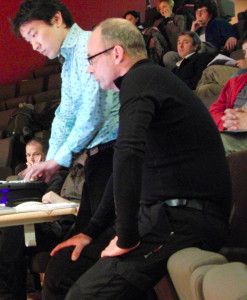for flute, clarinet, piano, percussion, piano and string trio (2015 version) 10’00”
(1-0-1-0 / 0-0-0-0 / 1 piano, 1 perc. / 1-1-1-0-0)
premier: 20:00- February 7th, 2015
Place: Le Studio Regards de Cygne, 210 Rue de Belleville, 75020 Paris, France.
Ensemble Regards
Conductor : Julien Béneteau
Flute : Amélie Feihl
Clarinet : Juliette Adam
Piano : Maria-Paz Santibanez
Violin : Aya Kono
Viola : Elodie GAUDET
Cello : Myrtille Hetzel
for flute, oboe, percussion and string trio (2012 version) 9’00
(1-1-0-0 / 0-0-0-0 / 1 perc. / 1-1-1-0-0)
premier: 20:00- february 7, 2015
Place: Le Studio Regards de Cygne, 210 Rue de Belleville, 75020 Paris, France.
premier: 20:00- september 27, 2012
Place: KULTUR- UND VERANSTALTUNGSZENTRUM KIWI, Dörferstr. 57, 6067 Absam, in Schwaz Austria.
musicians: Ensemble TIMF
Commission: Klangspuren Festival, Unsuk Chin, Ensemble TIMF
.. ” When I see phenomena of nature as like the crack of a glass or as like a flying ball, it begins my reflection on artistic dynamics. “. A composer, the fascination for the moment of nature, and energies of temporal processes. Keita Matsumiya – born in 1980 in Kyoto – lives and works in Paris, where he currently studies composition and conducting at the Conservatore de Paris. ” My inspiration often arises from communications with musicians with whom I work, and I would always do discussions as long as possible in order to enrich my understanding about each instrument’s nature and to observe the various gestures of musicians. This interest and the way of working would be also related with my concerns to the dynamism of the moment in nature. ”
Before Keita Matsumiya decided to become a composer, he had studied musicology and also dealt sound installations and projects with dancers and actors in Japan. In 2008 he went to Paris to study composition and electronic music mainly with Gerard Pesson and Frederic Durieux. He has obtained several scholarships and awards in France and Japan. His pieces are played at international festivals – both in Asia and in Europe. On the piece “La rose(é) des vents” for flute, oboe, percussion and string trio, Keita Matsumiya says:
.. We can only perceive limited amount of time. Our perceptions towards the moment in blinking eyes are so limited as to the lifetime of a planet. The drop running on the surface of a leaf, for example, our eyes cannot properly catch up with its transition, in such an instant. In other words, we can’t do well as a high speed camera. So I imagine, a drop starts to line on the veins from the point of falling: how it reflects its surroundings in flying splashes, how it traces the shape of veins in the wind, how it varies its transition by the volume of dew, by the power of falling on the leaf, and etc. After its falling out of routes, everything will go back in order, just remaining slight tremors of the leaf. In this piece, I’ve tried to picture such lives in an instant of single blink as a space of perceivable time, and I hope it would be created by musicians.”
*quotes from the program note originally written in German


































